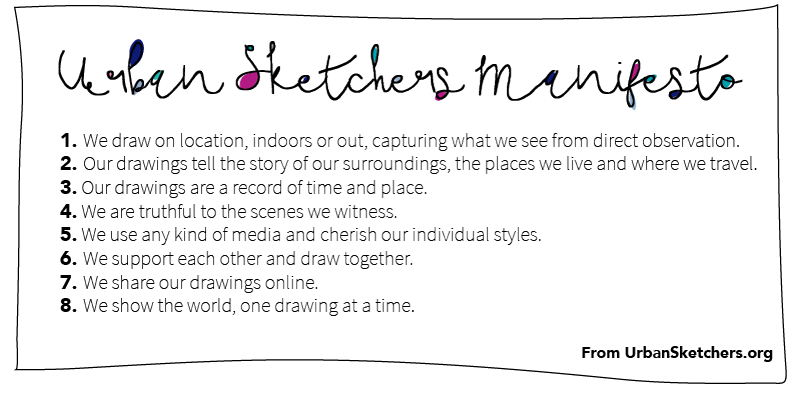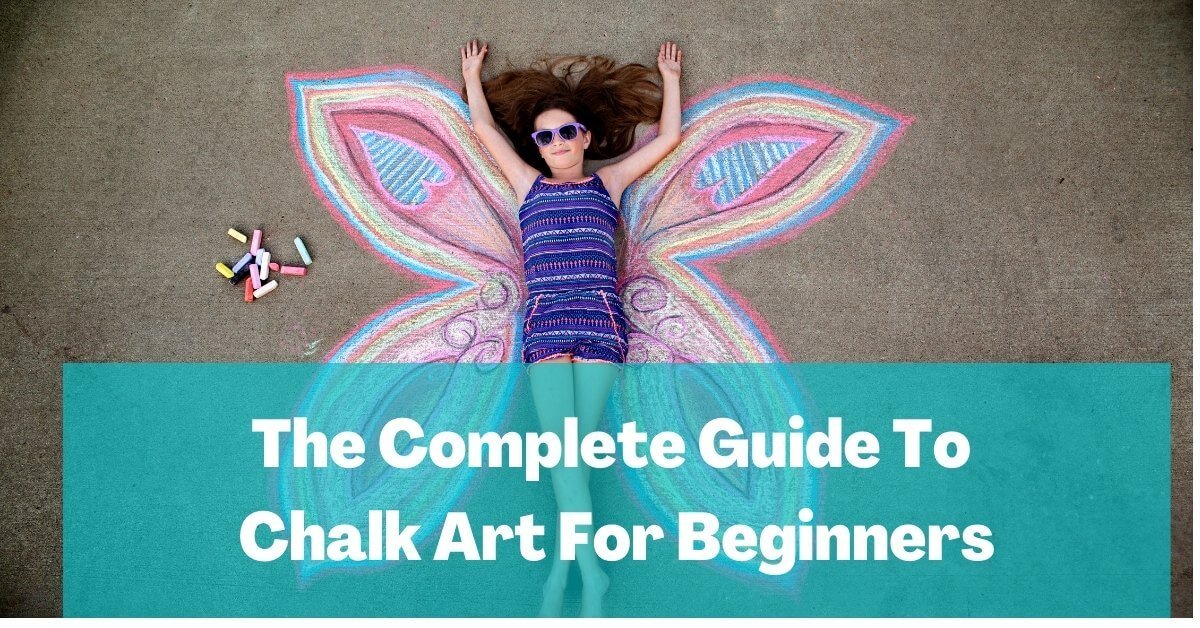What in the world is urban sketching?!
Urban sketching is an amazing and creative form of art that is perfect for artists of ANY skill level. Seriously. It’s one of the most relaxing ways to document the world around you.
It’s also a great way to meet new people! The urban sketching community has skyrocketed in popularity in the past ten years, with sketch crawls happening worldwide (like bar crawls except with art!).
Even if you’re not the best artist, this hobby is DEFINITELY one I recommend everyone to try out.
Want to take an urban sketching class? I’ve partnered with the creative crew at Sketchbook Skool on their online Urban Sketching course.
Sign up for the class here to join in class discussions and share your artwork with classmates!
Introduction To Urban Sketching
So what exactly is urban sketching? Urban sketching is drawing while on location in areas you live in or traveling to.
You can sketch out your local farmer’s market, museums, beaches, temples, concerts, parks –you name it. You can sketch it! It’s a great way to document the world you live in or visit attractions while on vacation.
Can’t even draw a straight line? It doesn’t matter! The beauty of urban sketching artwork is its informality of it.
However… if you want to learn, you can always check out my beginner’s guide for drawing. Having a grasp of the basics is always helpful!
Urban sketching has a wide variety of benefits and is perfect for anyone who loves journaling or can appreciate art.
It allows you to explore and document the world around you. By sitting down and drawing on location, you’ll be able to really appreciate the beauty of life.
Even if you’re just sketching a busy parking lot. While sketching, you’ll need to decide which part of your view is important enough to capture in your artwork.
Sketching a scene allows you to capture more than you would if you were writing in a journal.
You’ll capture the atmosphere and your view. Well, can’t I just photograph it? You can.
Like you probably have, I’ve taken hundreds of photos of places I’ve been. However, when you take photos, you pretty much just snap and go.
There’s a much, deeper connection to the environment if you actually take the time to sketch it.
HISTORY OF URBAN SKETCHING
The global popularity of urban sketching is relatively recent. Although people have been documenting their lives by drawing the world around them for ages, the global community aspect of it has skyrocketed in the past 10 years or so.
In 2007, a Seattle-based journalist and illustrator named Gabriel Campanario founded a blog and online forum for urban sketches.
This allowed urban sketchers worldwide to share their artwork with others.
UrbanSketchers is now a non-profit organization that hosts the International Urban Sketchers Symposium annually and offers urban sketching workshops worldwide.
The UrbanSketchers.org manifesto pretty much tells you what urban sketchers are all about!

Around the same time, SketchCrawl was founded by Enrico Casarosa, a Pixar storyboard artist and director.
SketchCrawl is like a bar crawl but without beer. You meet other local urban sketchers to walk around and sketch various sites throughout the day.
It’s a great way to meet fellow artists and find new locations around your own hometown! I’ll touch more on the community at the end of this guide.
Tools Needed For Urban Sketching
Simply put, you only need something to draw with and something to draw on.
However, just having paper and pencil might not allow you to have the best experience possible while you are urban sketching.
Paper won’t be easy to carry so you might want to invest in a sketchbook or sketchpad. If you want to add colors on location, you can use colored pencils, art markers or watercolor.
Pencils
Many people like to sketch with a pencil first so they can erase mistakes or change how they first drew something.
Any pencil should do if you’re using a pencil just to lay down the foundations of your artwork.
However, if you want to use only a pencil for your artwork, you should be aware of the types of pencils available and which would be best for you. Check out this great sketch using only a pencil!
Pencils are categorized by two different scales. The HB graphite scale and the numerical graphite scale.
You’ll have to know what these mean and which type of pencil works best for you. For more information on pencils, check out my beginner’s guide to drawing supplies.
With different brands of pencils, you’ll have to experiment with the ones that work for you.
JetPens has a pretty great guide on pencil grades and even better guide on wooden pencils if you want to learn more.
Pens
If you want your artwork to last longer, you may want to consider using pens.
If desired, you could always sketch with a pencil first before adding pen ink. I prefer skipping the pencil stage altogether and starting with the pen.
This allows me to spend less time fixing and erasing mistakes and more time actually capturing what I’m drawing. You should try different pens to see which works best for you.
I love using Sakura Micron Pens since it uses waterproof, archival ink. This ink is also chemical-resistant, fade-resistant, bleed-free, and quick-drying as well.
The waterproof quality also helps if you want to add watercolor to your sketch.
These pens are also available in a variety of different sizes, so I’ll switch pens when I need to something that works well for refined details.
I started off with this pretty affordable pack of 8 pens (pictured) since it came in various sizes (0.2-mm, 0.25-mm, 0.3-mm, 0.35-mm, 0.45-mm, 0.5-mm) and a brush and graphic tip too!
These pens are also available in a few different colors as well. You can always use these to add color to your scene.
For a while, I was doing a lot of my urban sketching in just black and red ink. I used the red ink to accent certain areas of my sketch –like a fire hydrant, a woman’s dress or a kite.
The example below shows that you really don’t even need more than just a nice, solid pen to create some amazing sketches.
Colored Pencils
If you want to add color, you can use colored pencils. However, you’ll probably need a variety of colors to really capture your scene.
If you want a wide range of colors available to you on location, you’ll have to carry many different colored pencils. This can be difficult if you don’t want to carry many supplies around.
Like how I used red ink to highlight certain areas of my artwork, you can use colored pencils to do the same!
You don’t need to have hundreds of colors on your sketches to make them look awesome.
If you want to try using colored pencils, check out my beginner’s guide to colored pencils before you start.
Art Markers
Art markers are always a fun tool to use to add colors. However, like the colored pencils, you’ll need to carry quite a few of them if you want a wide range of colors available to you.
Art markers are much heavier than colored pencils so it can be a burden to carry them around.
Although you can probably achieve decent results by blending colors with a small set, you may realize that you want to capture WAY more colors than you have available.
However, if you don’t mind having a limited color palette, art markers may be a great option for you.
You can apply color pretty quickly (compared to colored pencils) with great results.
Some artists have used a range of shades for one color –such as gray or blue. If you understand highlights and shadows well, you can have a pretty awesome monochromatic piece of work.
My favorite art markers to use are Copic Sketch markers. When I’m the mood for art markers, I normally stick with carrying a small range of Copic markers for a monochromatic urban sketch session.
This is mainly because I hate carrying things. Copic also sells a pack of 6 shades of gray markers for those who like to create grayscale artwork (see right).
Copic has a neat color-coding system that makes it easier to choose colors that are easier to blend.
Find out how to do that by checking out my beginner’s guide to Copic markers. If you’re completely new to art markers, you may want to start at this guide instead.
Watercolor
You’ll see that many urban sketchers use watercolor to add color to their artwork.
Watercolor is great because you have a larger variety of colors available to you. There are also travel-sized palettes that are small enough to fit in your pocket or purse!
You can mix on these palettes, but colors can be mixed on paper by adding washes anyway.
When using watercolor, try not to paint your highlights and use the paper color as a highlight instead. Focus more on the mid-tones and shadows when using watercolor to add color to your urban sketches.
I currently use the Koi Pocket Field Sketch Box when I want to use watercolor while urban sketching.
It’s so compact and portable while still providing a lot of different colors. My current kit has 24 colors, but they have ones ranging from 12 to 30 colors within one set.
Another frequently used watercolor set is the Windsor and Newton Deluxe Sketchers Pocket Box.
Sketchbook
Most likely, you’ll want to carry a sketchbook for urban sketching. Not only does this keep all your sketches in one place, but it’s also more convenient and portable.
You should consider a few things while choosing a sketchbook that’s right for you.
Size
The size of your sketchbook will really be based on your preference. Smaller sketchbooks mean you could probably finish sketches quicker and move on to more locations. Larger sketchbooks mean you’ll be able to capture more of the scene both in distance and detail.
Paper
The type of paper will depend on the type of art supplies you are using. If you use art markers, you should find a piece of paper that won’t bleed through.
You may want to get a sketchbook full of watercolor paper for watercolor. If you need more info on paper weight or tooth, check out my beginner’s guide to drawing supplies.
Binding
The binding of the book is will depend on your preference too. Spiral-bound sketchbooks allow you to complete flip open to a particular page. However, drawing on the edge might be difficult.
Hardbound sketchbooks may be difficult to keep open. Some urban sketchers even work on accordion-bound sketchbooks to create an expansive panorama.
Other sketches like lined or graph paper within their sketches as a personal preference.
Sketching Techniques
There’s a variety of techniques that you should keep in mind while urban sketching. Although it helps to know how to draw to some extent, you don’t really need to as long as you are happy with the results.
These are your own sketches to document your own world. If that person you drew doesn’t really look like a person, who cares?
Sometimes it helps to have a good foundation in some of the basics of drawing. I’ve linked some guides I created that should help with that.
These guides were created to help you be familiar with some of these concepts over a one-week span. I included plenty of resources and videos to help you as you learn and practice.
BASICS (Part One)
This guide covers pencil holding techniques, 2D & 3D shapes, guidelines, proportions, silhouettes, and contouring. Super important if you’re just starting out.
BASICS (Part Two)
This covers drawing techniques, value, shadow, contrast, texture, reflection, and transparencies.
PERSPECTIVE
This guide covers 1-point, 2-point, 3-point (bird’s eye view & worm’s eye view), 4-point, and 5-point (fish-eye) perspectives. It also covers elliptical perspective and foreshortening.
Perspective is important to grasp if you want to get into urban sketching. It’s not necessary but urban sketching will allow you to get LOTS of practice on perspectives.
FIGURE DRAWING
This guide covers construction/pose, proportions, muscle structure, hands, feet, face, hair, and clothes for figure drawing. You can choose whether or not you want to include people in your sketches.
This guide will help you learn how to sketch them if you choose to. People may frequently move through your scene.
You don’t necessarily need to capture them perfectly. It’s just a sketch!
Developing Your own Style
Explore the works of popular urban sketchers to help inspire you to find your own style.
Each urban sketcher is unique in their style based on their mediums, the way they draw and their subject.
My biggest recommendation is to check out this Instagram account by UrbanSketchers.
They feature urban sketchers with varying styles using many different mediums.
This example below features an artist who utilizes only a black and white pen on brown paper to create a unique look for her urban sketches.
Choosing Locations & Subjects
If you are just starting out, you may want to pick a quiet and secluded location.
Try sitting outside your house and just draw the view across your street. Even if it’s not an ideal view (I used to live across a large dirt lot), you can still get the experience of setting up your sketch.
It’s helpful to frame your scene first and determine what you’ll draw for your view’s outermost right, outer left, top, and bottom.
Once you are comfortable with these scenes, venture out to other places around your city. When you draw these scenes, you can decide whether you what you really want to focus on.
Like the architecture of the church? Or maybe you like the variety of people you see at a festival?
Whatever it may be, spend more time on drawing those as the focus of your drawing. Don’t really have a focus and just want to draw the whole scene? You can do that as well!
Here are a few suggestions to get you started:
- Farmer’s market
- Festival/local events
- Store
- Museums
- Schools
- Parks
- Hospital
- Restaurants/Cafes
- Gardens
- Beach
- Church
Community
The urban sketching community is amazing. Many groups often meet up in their selected cities and choose a time and place to bring their sketchbooks.
It’s a great way to meet people and explore areas of your city you might not have ever known.
Don’t worry if you feel like a beginner. These groups welcome artists of all skill sets and experience levels!
Urban sketching is a global phenomenon! Through UrbanSketchers.org, you can find a huge list of official chapters located worldwide.
Find your country’s (or city’s) official chapter on this list and find the next urban sketchers meet-up.
You can also try to find a group of urban sketchers in your area if you search through the forums at SketchCrawl.org!
You can find most of the groups through a quick search on Facebook! Request to join and share your work!
Ready To Get Started?
Get your sketch pads and join me on this weekly schedule!
Week One
We aren’t going far for this one! Go outside your house, find a nice place to sit and sketch exactly what you see across from your home.
If you aren’t too thrilled about the view, turn around and draw your home instead. It’s a great way to capture where you’re living during this part of your life!
Week Two
Take your sketchbook out to a cute, local cafe where you may find people working on their laptops, reading, or maybe on a coffee date.
If you aren’t comfortable with sketching in public, this environment is perfect! Many people around you are working on their own things, so no one will notice you sketching!
Sit at a table with a view of either the coffee shop wall or the counter and draw what you see.
Week Three
Head to a local museum and find a great quiet spot. Try a museum you’ve frequented before so you don’t have to worry about the excitement you have to check out all the exhibits.
Lots of museums usually have a free admission day for locals. Find out when your free museum days are and head out then!
Week Four
Find a free, local event that is happening in your city and go people-watching.
Try sketching at a festival (like a cultural celebration where you can sketch some fun, lively decorations) or even a farmer’s market (where you can sketch tons of colorful fruits and vegetables).





